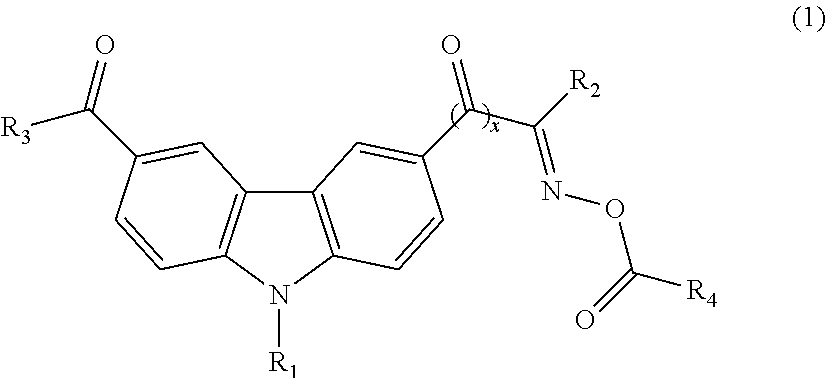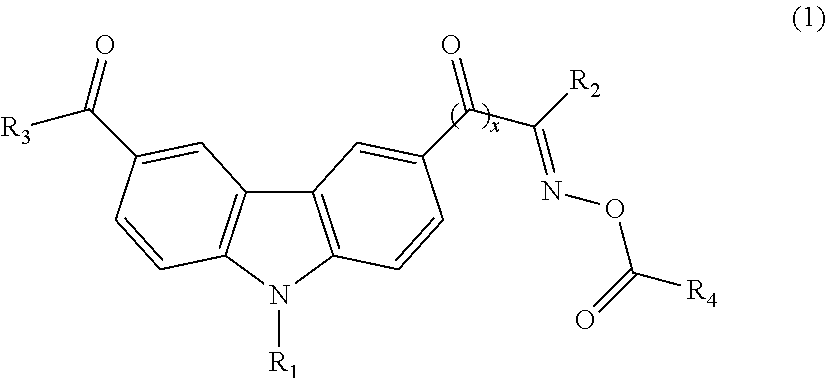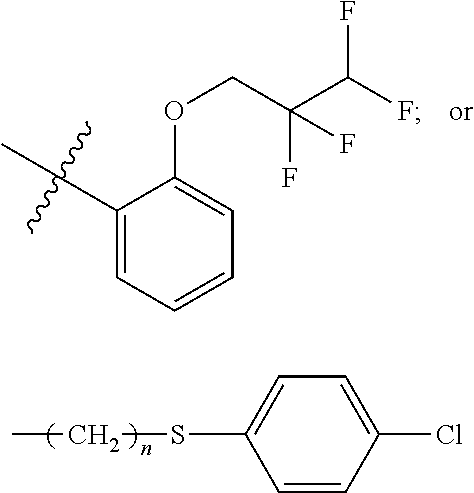Photoinitiator and photosensitive composition including the same
a technology of photoinitiator and composition, applied in the field of photoinitiator and photosensitive composition, can solve the problems of difficult cure of color resist, and achieve the effect of improving the characteristics of thin films
- Summary
- Abstract
- Description
- Claims
- Application Information
AI Technical Summary
Benefits of technology
Problems solved by technology
Method used
Image
Examples
example 1
Synthesis of the Compound of Formula 4-1
1 Step: Synthesis of 1-(9-(2-hydroxyethyl)-6-(thiophene-2-carbonyl)-9H-carbazol-3-yl)-2-(o-tolyl)ethanone
[0055]
[0056]100.0 g of 2-(9H-carbazol-9-yl)ethanol was dissolved in 600 mL of dry dichloromethane. The solution was cooled to 0° C., and then 66.3 g of AlCl3 was added thereto. To the mixture was slowly added 73.2 g of thiophene carbonylchloride at 5° C. The mixture was stirred at 25° C. for 8 h. After 66.3 g of AlCl3 was added. To the mixture was added dropwise 84.3 g of 2-(o-tolyl)acetyl chloride at 0° C. The reaction mixture was stirred at 25° C. for 7 h. After cooling to 0° C., the solution of the reactor was slowly added to 1200 mL of ice-water for layer separation, and washed with 1200 mL water. The organic layer was dried over anhydrous MgSO4, concentrated, and purified by column chromatography, giving 120 g (yield; 56%) of the 1-(9-(2-hydroxyethyl)-6-(thiophene-2-carbonyl)-9H-carbazol-3-yl)-2-(o-tolyl)ethanone.
[0057]1H-NMR (δ, ppm, ...
example 2
Synthesis of the Compound of Formula 5-1
1 Step: Synthesis of 1-(9-(2-ethoxyethyl)-6-(thiophene-2-carbonyl)-9H-carbazol-3-yl)ethanone
[0086]
[0087]23.9 g of the 9-(2-ethoxyethyl)-9H-carbazole as a reactant and 100 mL of dichloromethane were placed in a 250 mL round-bottomed flask, 15.8 g of aluminum chloride was added at 0° C., and a dilute solution of 17.3 g of thiophene carbonyl chloride in 16 mL of dichlomethane was added dropwise thereto. Following stirring at 25° C. for 5 h, 15.8 g of aluminum chloride was added and 9.5 g of acetyl chloride was added dropwise. The mixture was allowed to react at 25° C. for 5 h. After completion of the reaction, the resulting mixture was washed with water, dried over anhydrous MgSO4, and filtered. Concentration of the organic layer gave 31.3 g (yield; 80%) of the 1-(9-(2-ethoxyethyl)-6-(thiophene-2-carbonyl)-9H-carbazol-3-yl)ethanone as a solid.
[0088]1H NMR (δ, ppm, CDCl3): 1.10 (t, 3H), 2.50 (s, 3H), 3.50 (q, 2H), 3.85 (t, 2H), 4.45 (t, 2H), 7.27 ...
example 3
[0152]Preparation of Transparent Resist Composition
[0153]A mixture of 17 g of an acrylic copolymer, 13.6 g of dipentaerythritol hexaacrylate, 1.5 g of the compound of Formula 4-1 as a photoinitiator, and 67 g of propylene glycol monoethyl ether was thoroughly stirred to prepare a transparent resist composition.
PUM
| Property | Measurement | Unit |
|---|---|---|
| wavelengths | aaaaa | aaaaa |
| wavelengths | aaaaa | aaaaa |
| wavelengths | aaaaa | aaaaa |
Abstract
Description
Claims
Application Information
 Login to View More
Login to View More - R&D
- Intellectual Property
- Life Sciences
- Materials
- Tech Scout
- Unparalleled Data Quality
- Higher Quality Content
- 60% Fewer Hallucinations
Browse by: Latest US Patents, China's latest patents, Technical Efficacy Thesaurus, Application Domain, Technology Topic, Popular Technical Reports.
© 2025 PatSnap. All rights reserved.Legal|Privacy policy|Modern Slavery Act Transparency Statement|Sitemap|About US| Contact US: help@patsnap.com



